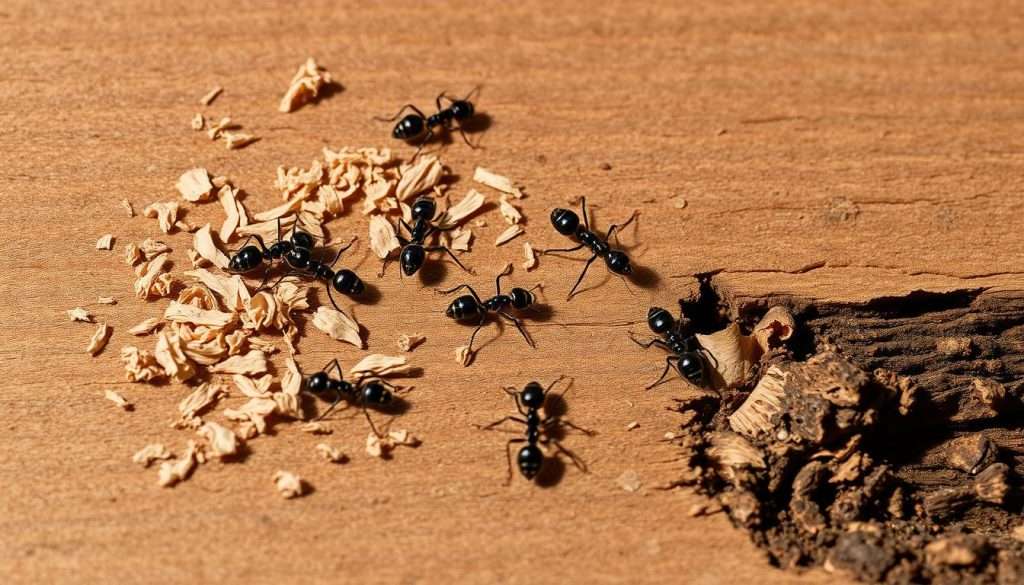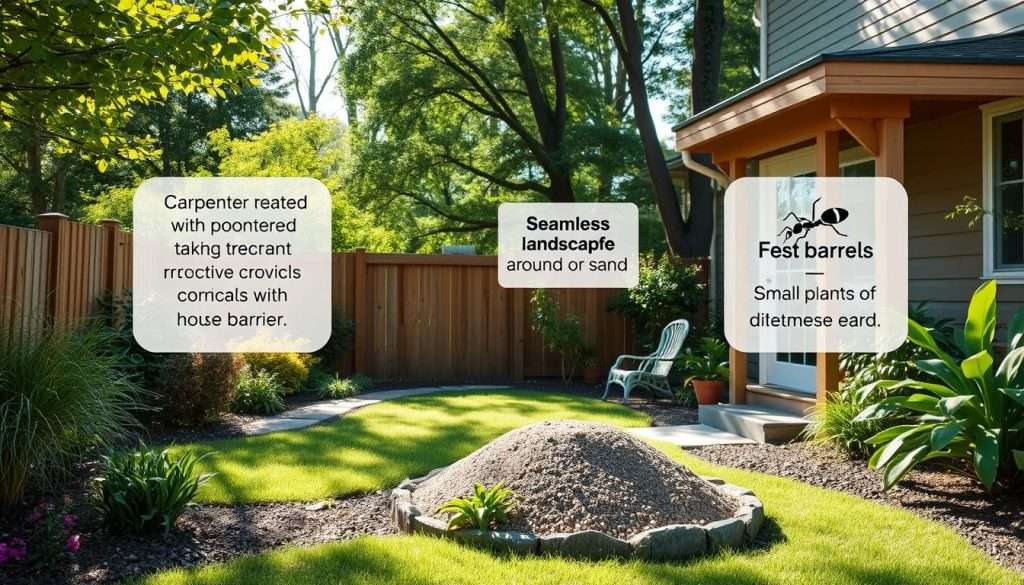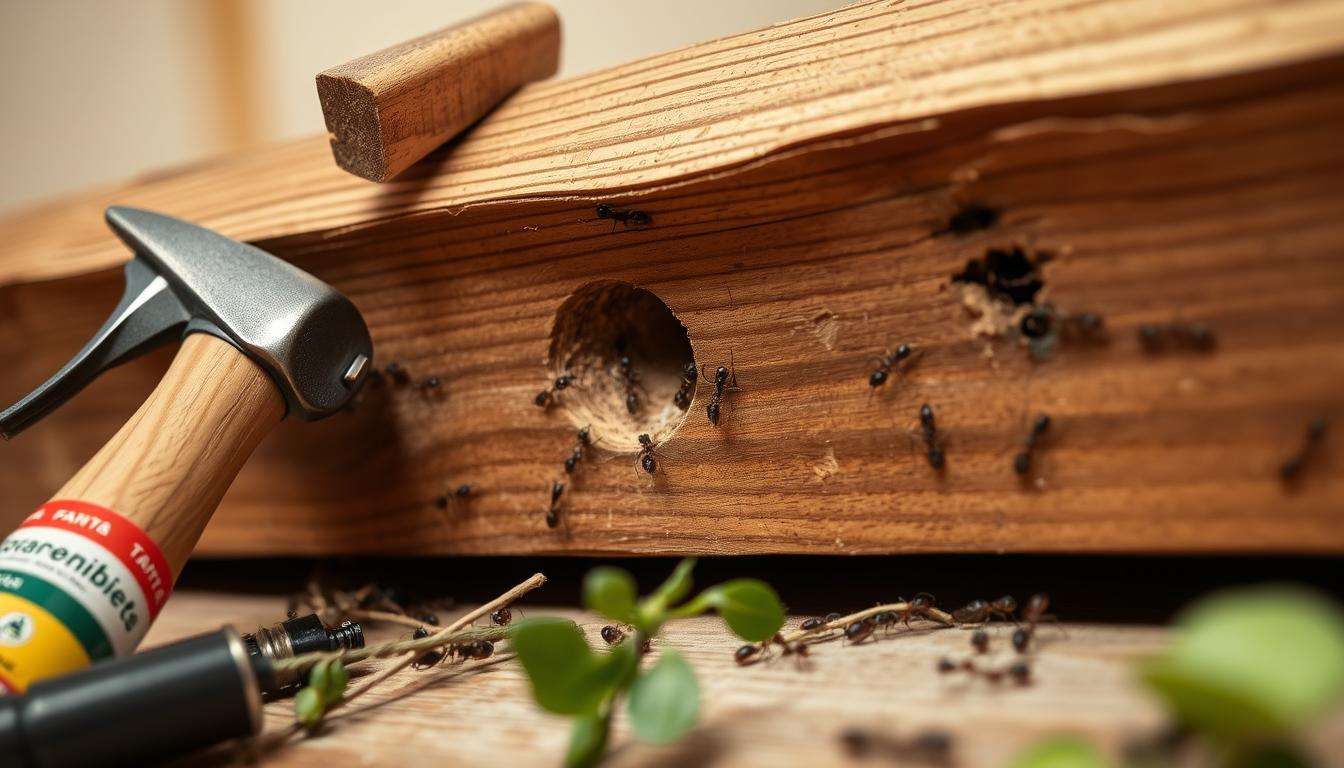Carpenter ants can damage your home if not dealt with quickly. This guide will show you how to control and get rid of them. Knowing about these pests helps protect your home.
We’ll talk about how to spot carpenter ants, the harm they can do, and how to treat them. With our tips, you can handle carpenter ant issues easily.
Key Takeaways
- Carpenter ants can be controlled with poisonous gel bait mixed with sugar and milk.
- Slow-acting bait affects the whole colony in about three days.
- Dusting with insecticides solves problems in nests you can reach.
- Boric acid can quickly kill ants when they bring it back to their nest.
- Sealing holes and keeping your home clean stops ants from coming in.
- Pest control subscriptions can protect your home from ants for a long time.
Understanding Carpenter Ants
Carpenter ants are wood-destroying insects that tunnel into timber. They prefer damp or decaying wood. Knowing about different types of carpenter ants and their behavior is key to stopping them.
These ants don’t eat wood but feed on insects, honeydew, and sweets. Their nesting habits let them live in both nature and human-made places.
What Are Carpenter Ants?
Carpenter ants are interesting creatures. They are 3/8 to 3/4 inch long and come in black, reddish-brown, or yellowish colors. A queen can lay 15 to 20 eggs at once, helping colonies grow fast.
Colonies can have up to 3,000 workers in three to six years. Carpenter ants are often confused with termites. But unlike termites, they don’t eat wood. They tunnel through it to make nests.
Why Do Carpenter Ants Invade Homes?
Moisture is the main reason carpenter ants invade homes. They look for damp or rotting wood near water leaks or decaying materials. Spotting them indoors in winter means there’s a nest inside.
Preventing moisture and checking wooden structures for damage is important. Knowing how carpenter ants behave helps you stop them. Fixing issues and sealing entry points are good ways to prevent them.
Identifying Carpenter Ant Infestations
Spotting carpenter ants early can save your home from big damage. Knowing the signs of an infestation is key. It’s also important to tell carpenter ants from termites to act fast.
Common Signs of Infestation
Look out for these carpenter ant signs:
- Sightings of large, winged ants indoors, especially during spring mating flights.
- Piles of wood shavings (frass) beneath wooden items, indicating active tunneling.
- Small holes in wood where carpenter ants have been excavating.
- Polished and smooth galleries in wood structures, which carpenter ants maintain clean.
These signs point to a long-term infestation. Seeing swarms indoors means thousands of ants might be living in your home.
Distinguishing Carpenter Ants from Termites
Here’s how to tell carpenter ants from termites:
| Feature | Carpenter Ants | Termites |
|---|---|---|
| Body Shape | Distinctively segmented body with a narrow waist | Broad, continuous body without a segmented appearance |
| Antennae Structure | Elbowed antennae | Straight antennae |
| Nesting Materials | Excavate wood and do not consume it | Consume wood and create debris-filled nests |
| Gallery Appearance | Smooth, debris-free galleries | Rough, debris-filled galleries |
Knowing these differences helps you spot carpenter ants. This lets you choose the right pest control to protect your home.

Why Carpenter Ants Cause Damage
Knowing about carpenter ant problems is key for homeowners. These ants are big pests in the Pacific Northwest. They don’t eat wood like termites do. Instead, they dig it to make nests, which can weaken buildings.
Ignoring carpenter ant signs can lead to expensive fixes later.
Understanding Carpenter Ant Damage
Carpenter ants can weaken a building’s base by digging out wood. This makes the structure less strong. You might see:
- Stuck doors and windows
- Sinking ceilings
- Sloping floors
- Warping framing
- Bulging walls
Frass, or sawdust, is another sign of carpenter ants. You can find it in crawl spaces, basements, and near windows. Spotting these signs early can stop more carpenter ant damage and costly fixes.
Comparing Carpenter Ants and Termites
Looking at pest threats, comparing termites to carpenter ants is helpful. Both harm wood, but differently. Carpenter ants don’t eat wood; they tunnel through it and throw out debris.
This difference helps homeowners know how to act fast. For more on carpenter ants, check out this article.
How to Get Rid of Carpenter Ants
Dealing with carpenter ants can be tough. But, with the right steps, you can take back your home. Using a mix of methods is key. This includes toxic bait, direct nest treatment, and insecticide application.
Using Toxic Bait for Effective Control
Toxic bait is a strong tool against carpenter ants. Products like Advion Ant Bait Gel draw in workers. They carry the bait back to their nest, killing the whole colony. It’s important to check the bait stations often. Replace or add bait as needed to keep the ants coming.
Direct Nest Treatment Methods
If you can reach the nest, direct treatments work fast. Dust products like D-Fense Insecticide Dust target the nest. Put the dust in gaps or crevices. This method quickly kills ants in the nest.
Applying Insecticides and Sprays
Insecticide application is a common way to get rid of carpenter ants. Non-repellent insecticides, like Termidor SC and Phantom, are best. They let ants carry the poison back to the nest. This increases the chance of killing the whole colony. Use these sprays often, especially in cracks and crevices, to keep your home pest-free.
| Method | Description | Effectiveness |
|---|---|---|
| Toxic Bait | Uses bait that foraging workers carry back to the nest, targeting the colony. | High – eliminates entire colonies over time. |
| Direct Nest Treatment | Involves applying insecticide dust directly to accessible nests. | Very High – immediate impact on exposed ants. |
| Insecticide Application | Utilizes non-repellent sprays to affect ants as they pass through treated areas. | High – systematic elimination as ants return to nest. |
Steps to Locate a Carpenter Ant Nest
Finding a carpenter ant nest is hard. These ants make big tunnels in wood, so you can’t see their homes easily. You need a good plan to find their nests. By looking at possible places and following their trails, you can find and fix the problem.
Finding Potential Nesting Sites
Start by looking in places carpenter ants like. They often nest in:
- Damp or rotting wood, like beams and door frames
- Wall voids near plumbing
- Under rotting tree stumps or wood piles in your yard
- Near insulation or in exterior walls
Look for signs like frass (wood shavings) and sounds like crinkling cellophane. They smell bad, like rotten coconut, when stepped on. They like dark places, so look in spots that are hard to see.
Following Ant Trails for Nest Location
Watching carpenter ant trails can show you where their nest is. Here are some tips:
- See a lot of ants going in and out? That’s a sign of a problem.
- Follow the ants as they look for food, usually within 300 feet of their nest.
- Find trails leading to food. Ants carry food back to their nest.
Finding carpenter ant nests takes time and attention. Knowing these steps helps you solve the problem for good.
Carpenter Ant Prevention Strategies
Stopping carpenter ants before they start is easier than fixing a problem later. Good strategies can help keep these pests out of your home.
Moisture Control and Wood Maintenance
Keeping moisture away from your home is key to stopping carpenter ants. They love damp places. Here are some tips to keep your home dry:
- Fix any leaks in your plumbing and roof.
- Make sure water drains away from your home’s foundation.
- Use dehumidifiers in damp areas like basements and crawl spaces.
- Check for and fix any wood damage, as it attracts carpenter ants.
Also, manage wood materials near your home. Keep firewood away from your house. Remove wood debris or stumps in your yard that could hide nests.
Sealing Entry Points to Your Home
It’s important to block carpenter ants’ ways into your home. Here’s how to seal entry points:
- Check windows and doors for gaps. Use weather stripping to keep them out.
- Seal cracks and crevices in walls, especially around pipes and vents.
- Make sure chimney caps are on and in good shape.
- Fix any damaged screens.
By following these steps, you can make your home less appealing to carpenter ants. A proactive approach, including controlling moisture and sealing entry points, is essential for preventing carpenter ants.

| Strategy | Action | Benefit |
|---|---|---|
| Moisture Control | Repair leaks, use dehumidifiers | Reduces damp environments |
| Wood Maintenance | Fix wood damage, remove wood debris | Less attraction for carpenter ants |
| Sealing Entry Points | Seal cracks, repair screens | Blocks access for pests |
| Proper Drainage | Direct water away from foundations | Prevents moisture accumulation |
DIY Carpenter Ant Treatment Options
Dealing with carpenter ants? You can try DIY methods to control them. You can use natural treatments or commercial products. This lets you choose what works best for you.
Natural Remedies and Effective Home Solutions
Natural treatments are a soft but effective way to fight carpenter ants. Here are some ideas:
- Boric Acid: Mix boric acid with powdered sugar. The sugar attracts ants, and the acid kills them.
- Diatomaceous Earth: This powder dries out ants by harming their skin. Use it where ants are seen to get quick results.
- Essential Oils: Peppermint, tea tree, and citrus oils can keep ants away. Spray them around entry points to stop ants from coming back.
- Vinegar Solution: A mix of water and vinegar cleans surfaces and stops ants from following their trails.
- Home Remedies: Bay leaves and garlic can also keep carpenter ants away naturally.
Commercial Products for Carpenter Ant Removal
If DIY methods don’t work, there are commercial products for ants. Here are some options:
- Maxforce Fleet Ant Bait: This bait attracts and kills carpenter ants. It works slowly so ants can carry it back to their homes.
- Advance 375A Ant Bait Gel: This gel bait is tasty to ants and helps reduce their numbers.
- Carpenter Ant Bait Combo: This product targets carpenter ants’ special behaviors to get rid of them efficiently.
Subscriptions for pest control can also help. They offer ongoing solutions to keep carpenter ants away. Regular checks and DIY methods can protect your home from these pests.
Conclusion
We’ve looked into how to manage carpenter ants in this guide. Spotting an infestation early is key to avoiding big damage. Carpenter ants love moist wood, so keeping your wood dry is important.
Using different ways to keep carpenter ants out, like sealing holes and keeping things clean, helps a lot. Watching for signs of carpenter ants and using natural methods or pest control when needed keeps your home safe.
Knowing how carpenter ants act and live helps you fight them. With the right tools and knowledge, you can stop them from coming back. This keeps your home safe for you and your family.
